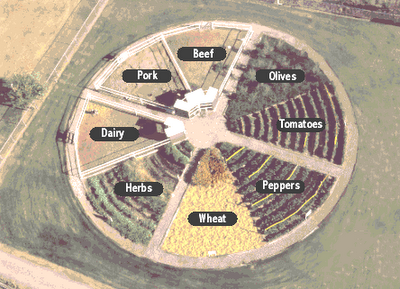Pizza Farms
In November of 2011, the United States Congress declared pizza to be a vegetable — if you believed the fast-spreading meme accelerated by some major news media. As the Washington Post explained, however, the hullaballoo was overblown (albeit not entirely baseless). The tomato paste on a slice of pizza is the “vegetable” — a serving size which could be as much as half a cup. The pizza itself still needs to be measured for calories and fat content, as Federal regulations put limits on both when it comes to school lunches; as the Post said, “a cafeteria worker can’t just pile a slice of pizza on a plate and say she’s serving salad.”
But if you ask a couple of farmers in the United States, there’s a good way to make everyone happy: a pizza farm.

As seen above, a pizza farm is a parcel of farmland subdivided into eight slices. Each subdivision is responsible for an ingredient in what, after a bunch of processing and cooking, becomes a pizza. The wheat is used to develop the crust, the “dairy” section (like the “beef”) is where cows graze, the tomatoes provide the sauce, and the rest can later become toppings. And much like school lunches, these pizza farms enrich the educational process. Perhaps even more so.
The pizza farms, of course, can’t produce a lot of peppers or pepperoni, certainly not enough to make a dent in the overall diets of American schoolchildren. But what they can do — and what they’re designed to do — is attract elementary school students via field trips. One Illinois second grade teacher told USA Today in 2005 that her class had visited The “R” Farm every year since it opened. On these trips, students (and their chaperone parents) learn about the food services industry, and, perhaps more interestingly to the children, where all the parts of a pizza come from.
There are not a lot of pizza farms out there — there’s the above-mentioned one in Illinois, one in Colorado, another in California, and probably a half-dozen others (including, perhaps, one in the UK; it’s unclear if that farm is actually shaped like a pizza pie). Visiting one is, therefore, difficult, so you may want to grow your own. (No pigs or cows there, though.)
Bonus fact: Pizza farms aren’t the only way that farm owners are trying to attract tourists. Corn mazes — quite literally, human-navigable mazes cut out of acres and acres of corn fields — are common throughout much of North America and the United Kingdom. But sometimes, they can be tricky. In October of 2011, a family with two children under five years old in tow got lost in a Massachusetts corn maze. When dusk fell, they panicked, and called 911. The police, replete with a K-9 unit, came to the scene to help the family find the exit.
From the Archives: Thirty Minutes or Less: How eating pizza every day saved a woman’s life.
Related: A pizza kit which advertised “just add your favorite toppings,” in case you grow your own after all.

Leave a comment